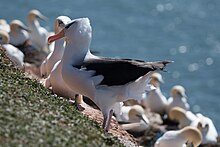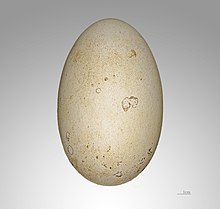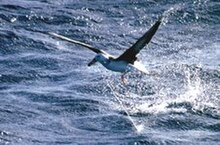Black-browed albatross
| Black-browed albatross | ||||||||||
|---|---|---|---|---|---|---|---|---|---|---|

Black- browed albatross ( Thalassarche melanophris ) |
||||||||||
| Systematics | ||||||||||
|
||||||||||
| Scientific name | ||||||||||
| Thalassarche melanophris | ||||||||||
| ( Temminck , 1828) |
The Black- or MollyMauk ( Thalassarche melanophris ) is a bird art from the family of albatrosses (Diomedeidae). He is the most widespread and common representative of the family. The black -browed albatross (often referred to as the black-browed albatross ) belongs to the order of tubular noses .
The black-browed albatross spends most of its life in the air over the Southern Ocean . But he has already been spotted on his long wanderings in the North Atlantic and as an extremely rare exceptional guest in Central Europe.
Since 2014, a solitary bird has caused a sensation, which regularly in spring and summer etc. a. is sighted on Heligoland and in the area of the north-west coast of Denmark.
Appearance
The black- browed albatross can be distinguished from the wandering albatross ( Diomedea exulans ) by the dark eye stripes that give it its name and the wide black wing edges on the otherwise white underside. The wingspan of a fully grown specimen can reach a size of up to 245 centimeters. The species is about 80 to 83 centimeters tall, the height averages 63 centimeters when standing. Black-browed albatrosses weigh between 2.9 and 4.6 kilograms. This makes the black-browed albatross one of the smallest albatross species.
The two sexes do not differ in appearance. Adult birds have a yellow beak , while it is gray in juvenile birds. Young birds are generally more gray in color, especially around the neck. In adult black-browed albatrosses, the head and the rest of the body are white. The tail of these birds is short and gray. The long, narrow wings are a masterpiece of evolution and aerodynamics . The black-browed albatross can hover close to the waves for hours without flapping its wings.
It can be confused with the Campbell albatross , which used to be a subspecies of the black -browed albatross .
distribution and habitat

The black-browed albatross breeds on islands around the Antarctic . The nominate form T. m. melanophris breeds in the Cape Horn area , the Falkland Islands and South Georgia, and the South Sandwich Islands . A second subspecies, T. m. impavida , breeds exclusively on the Campbell archipelago belonging to New Zealand . This subspecies is now classified by most authors as a separate species Campbell albatross ( Thalassarche impavida ).
Like almost all albatross species, black-browed albatrosses nest in colonies that often consist of several thousand birds, and mixed colonies of rockhopper penguin and albatross can also arise ( Falkland Islands ). The Falkland Islands are among the most important breeding areas of the species. It is believed that around 75 percent of the world's population breed on the islands of this archipelago. For the avifauna there , the black-browed albatross is the second most common breeding bird species. The most famous breeding colonies on the Falkland Islands are here:
- Steeple Jason Island (northwest of the main Falkland Islands), world's largest colony of black-browed albatross
- Saunders Island
- Carcass Island
- West Point Island
- Beauchene Island , large colony with tens of thousands of breeding pairs
The black-browed albatross spends most of its life in the air over the Southern Ocean , and it is particularly common in the Drake Passage . From 1860 to 1894, a specimen named Súlukongur lived for 34 years - until it was shot - under the gannets on the Faroese island of Mykines . Another bird of this species summered in changing Scottish gannet colonies between 1967 and 2007 . Since a second black-browed albatross was never seen in another colony at the same time, it is now almost certain that - as with Súlukongur - it was always the same bird. This bird - called "Albert" - was last at least 47 years old and had spent at least 40 years of it in the northern hemisphere.
In Central Europe, sightings are even rarer and the black-browed albatross is an extremely rare exceptional guest here. An individual of this species was seen in Belgium in December 1980 and in Lower Saxony in October 1988.
From 2014 to 2019, an individual was spotted on the North Sea island of Helgoland on isolated days in spring and photographed several times. There are other records of the same bird from the extended North Sea region from the same period, including from 26 May 2014 from Denmark north of Skagen , from Klädesholmen near Gothenburg in Sweden and from France, for example from 13 August near Le Havre . In Germany, the bird was also seen in the area around Sylt, including on April 21, 2017 in the Rantum basin . In 2017, the bird was mostly in the Rantum basin on Sylt (until mid-August). Presumably the same bird was seen in the British Farne Islands ( Northumberland ) in late June 2017 .
Reproduction
The animals of this species are very faithful birds. The pairs usually come together every year to breed together. They prefer the cliffs of the islands off the Antarctic as nesting sites, because from there they can make better use of the updraft when taking off. They only come ashore for brood and brood care, where the pair usually only hatches one egg.

To survive in the cold and harsh climate, young black-browed albatrosses are protected from the cold by a thick layer of fat and a thick down coat. The parents take turns caring for the brood. While one parent often travels many kilometers in search of food, the chick and the other parent wait ashore. The rearing time of the young takes about four months. The young then leave the country and spend all the time in the open sea until they reach sexual maturity. This occurs around the age of four. Like most albatrosses, the black-browed albatrosses have developed a trick to protect themselves from predators. When attacked, they also spray the enemy or attacker with oil from their nostrils. This oil comes from the animal's stomach and has a very unpleasant rancid smell.
nutrition
The main diet is squid , crayfish and krill . Like many seabirds, the black-browed albatross also takes in seawater and excretes most of the salt content through the nasal glands . There is evidence that this species has benefited, at least in the short term, from the increase in commercial octopus fisheries in the waters around the Falkland Islands. This type of fishing is mostly found near Beauchene Island , the southernmost of the Falkland Islands. Five percent of the catch is thrown back into the water and fifty percent of that is eaten by the black-browed albatross. The long-term impact is likely to be disadvantageous, however, as the stocks were overfished very quickly.
Danger
Like most albatross species, the black-browed albatross is on the Red List of Endangered Species . The animals often follow fishing vessels. The longlines in particular are dangerous for them. Many albatrosses perish on the hooks of these longlines, which can be over 100 kilometers long and have over 20,000 hooks. Fishing lures are attached to these hooks, but albatrosses are also often prey to this method. Often they get caught on the hook and drown as soon as their weight drops the line.
supporting documents
literature
- Hadoram Shirihai: A Complete Guide to Antarctic Wildlife - The Birds and Marine Mammals of the Antarctic Continent and Southern Ocean , Alula Press, Degerby 2002, ISBN 951-98947-0-5
- Robin and Anne Woods: Atlas of Breeding Birds of the Falkland Islands , Anthony Nelson, Shorpshire 1997, ISBN 0-904614-60-3
Web links
- Thalassarche melanophris in the endangered Red List species the IUCN 2008. Posted by: BirdLife International, 2008. Accessed on December 31 of 2008.
- Black-browed albatross at medienwerkstatt
- Black-browed albatross off the coast of South Africa
- Albatros cameras take spectacular photos , Spiegel-Online from October 7, 2009
Individual evidence
- ^ Photo credits from 28./29. May 4th / 5th June and 12./13. June 2014 on Heligoland. Report with photos in Der Falke No. 8/2014, pp. 34–37.
- ^ Shirihai, p. 118
- ^ Shirihai, p. 117
- ↑ Wood, p. 43 and p. 44
- ↑ a b Christian Walther: ANTARCTICA . 10th edition. Conrad Stein Verlag, Welver 2018, ISBN 978-3-86686-965-3 , pp. 255 .
- ↑ No romance for lovesick albatross (engl.)
- ↑ Hans-Günther Bauer, Einhard Bezzel and Wolfgang Fiedler (eds.): The compendium of birds in Central Europe: Everything about biology, endangerment and protection. Volume 1: Nonpasseriformes - non-sparrow birds , Aula-Verlag Wiebelsheim, Wiesbaden 2005, ISBN 3-89104-647-2 , p. 210
- ↑ Heligoland 2014
- ↑ Helgoland 2015
- ↑ Helgoland 2016
- ↑ Helgoland 2017
- ↑ Photo credit from May 26, 2014 on the northern tip of Denmark
- ^ Evidence from Sweden in September 2016
- ^ Sighting Sylt, April 2017
- ↑ Wood, p. 43




